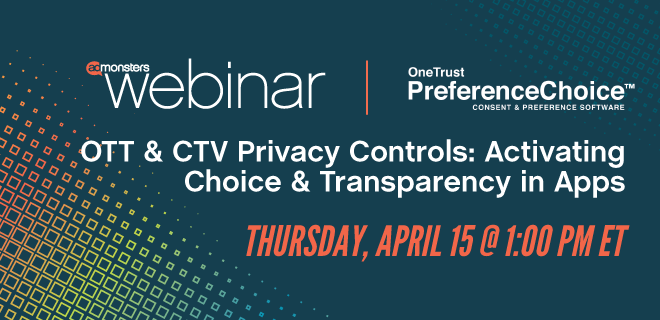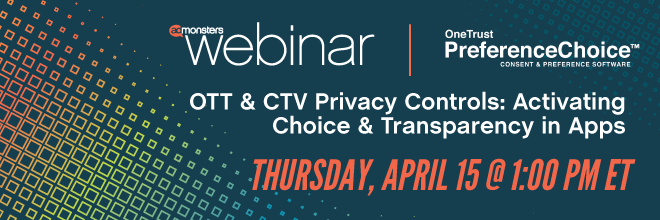
The shift to OTT and CTV creates an opportunity for publishers to engage a growing audience and deliver personalized experiences – and that includes privacy controls. While mobile OTT and CTV apps are somewhat new territories when it comes to privacy, it’s important for media companies to be transparent about how they’re using and collecting viewer data.
In preparation for our upcoming webinar, OTT & CTV Privacy Controls: Activating Choice & Transparency in Apps, on Thursday, April 15 @ 1 PM EST (Register now!), AdMonsters Head of Content, Tameka Kee, spoke with Alex Cash, Consent and Preference Management Lead, OneTrust, about what transparency really means, standardizing privacy management in CTV/OTT, and how the buy-side can help with managing consumer privacy and transparency.
Tameka Kee: “Transparency” can have a different meaning or connotation depending on who you’re talking to. For example, a media buyer might want transparency in terms of where and when their ads ran, while a media company would want to know which shows or time slots got them the highest CPMs. What do you think transparency means to the consumer when it comes to CTV/OTT – and how does that translate to what publishers need to communicate to them?
Alex Cash: Transparency to me is not just being honest and open, but a method of communicating. I can tell someone a full truth but in language that they may not understand, or I can honestly describe a concept that they do not have the context to truly appreciate the impact of.
So to me transparency is not just saying who you are and what data you’re looking to use, but what that means to the user in easily understand phrasing. Extra points for also explaining how the choices they make can benefit them. For example, we can explain that we want to use an identifier so that we can conduct frequency capping and that will mean they don’t get spammed with the same uninteresting ads; this clearly communicates the value exchange in an accessible and transparent way.
Additionally, transparency is not just language, but UX. Hiding controls, buttons, and options in hard-to-find locations makes no sense – as a consumer I want to manage my profile data right alongside my consents and data sharing options – don’t separate them! Make it easy.
Ultimately transparency is a vehicle to generating trust, and trust is hard to create, but easy to lose.
TK: With different devices, service providers, contextual environments, etc. creating a “standardized” privacy management strategy for CTV/OTT seems almost impossible. Are there ways for pubs to start streamlining this process, or are we too early in the game?
AC: Inevitably, as with any rapidly developing technology, standardization is challenging to adopt from the start. There are two areas worth exploring in conjunction to start with:
-
- Look to industry bodies! For example, IAB Europe’s TCF is designed to be a multiplatform framework, so here is definitely an opportunity to simplify.
- Your requirements on Web, Mobile, and across the myriad OTT/CTV platforms will likely be consistent in terms of what the user is asked to agree to/allowed to opt-out of. Additionally, you may find you’re using the same providers on multiple platforms. If this is the case, there is a good chance you have similar integration options in multiple locations, with only minor differences based on the platform in question – this can majorly simplify development and testing of any privacy signaling implementations.
TK: Media companies collect user data partly for their own purposes, but primarily to be able to help deliver value to their ad partners. So much of the onus in terms of managing privacy and transparency seems to fall on pubs (and partners like OneTrust). Is there room for the buy-side to help with this? Any thoughts or examples of what that could look like?
AC: In many ways, the onus being on the pubs is inevitable, as they’re the organization with ownership of the UX which is where so many of these principles are demonstrated. And I think it’s fair to say that’s a good thing – it’s good that Pubs have that ownership and control to curate an experience that matches their values.
We do already see buy-side orgs engaging in standards for disclosure and actively seeking consent where required (thinking of the TCF here!) – but I do believe we have additional options for expansion. Much like Apple’s new Nutrition Labels, I’d personally like to see a standardized approach for how pubs and vendors can disclose who they are, what they want to use data for, and where it’ll be shared in a universally consistent way. I believe this could feed into those concepts of transparency as we standardize the industry around educating end-users on what their data truly powers – but we can’t leave the responsibility for this entirely on the businesses who do own the end-user experiences.
Don’t forget to sign up for our webinar with OneTrust, OTT & CTV Privacy Controls: Activating Choice & Transparency in Apps, on Thursday, April 15 @ 1 PM ET. We’ll be speaking with Alex Cash and Tegna’s VP of Digital Products, Chris Fehrmann, about how Tegna is on the path to providing transparency and choice with their OTT audience and how you can also build trust within your streaming app.

